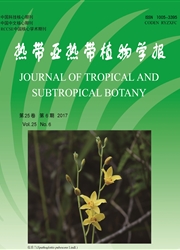

 中文摘要:
中文摘要:
选择华南热带区小良试验站中光裸地、桉树林、阔叶混交林和村边次生林4种不同恢复阶段的植被类型,测定不同层次的土壤容重、持水量、孔隙度等参数。结果表明:光裸地土质结实,容重在1.5gcm^-3以上;种植桉树后如果长期人为去除地表枯落物,其地表更为板结,土壤持水能力极差。桉树林改造为阔叶混交林后,0~40cm土层的容重均低于1-3gcm^-3,土壤总孔隙度为46.1%~51.4%,非毛管孔隙度15.0%~22.7%,土壤持水能力明显优于光裸地和桉树林。混交林土壤0~40cm层次的最大蓄水量达到1892thm。,比光裸地和桉树林分别多269thm^-2和418thm^-2。村边次生林土壤容重最低,表层(0~10cm)仅1.07gcm^-3,土壤总孔隙度为58%,土壤最大持水量可达538gkg^-1,均明显优于阔叶混交林。光裸地在26年间容重下降了27.7%,但其容重仍较大,阔叶混交林土壤由于系统功能的整体改善,土壤也变得更疏松,土壤持水能力有较大幅度提高,而桉树林土壤长期保持板结状态,土壤持水能力变化不大。建立种类多样、结构复杂的人工林可以显著增强地表水的入渗能力和土壤持水能力。
 英文摘要:
英文摘要:
Soil water holding capacity of plantations established on severely eroded lands was studied in tropical region of South China. Four plantations representing a chronic series of restoration, including barren land, Eucalyptus forest, mixed broad-leaved plantation and secondary natural forest, were compared. Soil bulk density, Water holding capacity and soil porosity were determined. The results showed that barren land with little vegetation cover had high soil bulk density ( 〉 1.5 g cm-3), and Eucalyptus plantation established on barren land made soil hardened and the water holding capacity became worse partly because of litter removal by villagers. Replacement of Eucalyptus plantation with mixed broad-leaved plantation markedly increased the water holding capacity of soil. Soil bulk density (0-40 cm) of the mixed broad-leaved plantation was below 1.3 gcm-3, and the total porosity was 46.1%-51.4% ,and their non-capillary porosity were 15.0%-22.7% .The maximum water storage of the soil (0 -40 cm) was 1892 t hm2, a level similar to those of many other broad-leaved forests. The secondary natural forest located nearby had a better water-holding capacity than the mixed broad-leaved plantation. The surface soil bulk density was only 1.07 gcm-3, and the total porosity was 58%, and the maximum water-holding capacity was538 g kg-1. Compared to those in 1983, mixed broad-leaved plantations largely improved soil physical properties with lowered soil bulk density and enhanced water-holding capacity. However, soils of barren land and Eucalyptus plantation had changed little, with hard surface soil and low water holding capacity. The results indicated that establishment of highly diversified plantation could enhance water infiltration and water holding capacity of soil.
 同期刊论文项目
同期刊论文项目
 同项目期刊论文
同项目期刊论文
 The effects of vegetation types on soil properties and N transformations within 23 years forest rest
The effects of vegetation types on soil properties and N transformations within 23 years forest rest Seedling growth and soil nutrient availability in exotic and native tree species: implications for a
Seedling growth and soil nutrient availability in exotic and native tree species: implications for a The species-dependent responses of soil microbial community composition and respiration to fresh lea
The species-dependent responses of soil microbial community composition and respiration to fresh lea Effect of prescribed fire on soil properties and N transformation in two vegetation types in South C
Effect of prescribed fire on soil properties and N transformation in two vegetation types in South C Effects of root diameter and root nitrogen concentration on in situ root respiration among different
Effects of root diameter and root nitrogen concentration on in situ root respiration among different Effects of nitrogen-fixing and non-nitrogen-fixing tree species on soil properties and nitrogen tran
Effects of nitrogen-fixing and non-nitrogen-fixing tree species on soil properties and nitrogen tran Responses of photosynthetic parameters of Mikania micrantha and Chromolaena odorata to contrasting i
Responses of photosynthetic parameters of Mikania micrantha and Chromolaena odorata to contrasting i Structural and physiological responses of two invasive weeds, Mikania micrantha and Chromolaena odor
Structural and physiological responses of two invasive weeds, Mikania micrantha and Chromolaena odor Allelopathic effects of eucalyptus and the establishment of mixed stands of eucalyptus and native sp
Allelopathic effects of eucalyptus and the establishment of mixed stands of eucalyptus and native sp Stand level estimation of root respiration for two subtropical plantations based on in situ measurem
Stand level estimation of root respiration for two subtropical plantations based on in situ measurem Photosynthesis, chlorophyll fluorescence, and antioxidant enzymes responses of invasive weed Mikania
Photosynthesis, chlorophyll fluorescence, and antioxidant enzymes responses of invasive weed Mikania 期刊信息
期刊信息
